20 Flavorful Oceanian Saltwater Fish Dishes Worth Trying
Oceanian saltwater fish dishes represent a vibrant culinary landscape that reflects the rich marine heritage of island cultures.
These delectable preparations showcase the incredible diversity of seafood found in the pristine waters surrounding Oceania's archipelagos.
The region's coastal communities have perfected techniques to transform fresh catches into mouthwatering meals that tantalize taste buds.
Generations of fishers and home cooks have developed unique recipes that highlight the natural flavors of their marine bounty.
Local ingredients, traditional cooking methods, and cultural influences blend seamlessly to create extraordinary seafood experiences.
Oceanian fish dishes tell stories of connection between people, ocean, and sustenance through their innovative and deeply meaningful preparations.
Here are 20 popular Oceanian saltwater fish dishes that will transport you to sun-drenched islands and crystal-clear waters:
Popular Oceanian Saltwater Fish Dishes Worth Savoring
Waters off Oceania yield treasures cooked up in unique ways. Salty breezes and local spices infuse every saltwater fish recipe.
New Zealand Fish And Chips
New Zealand fish and chips are a beloved takeaway tradition brought by British settlers before World War I, featuring locally caught white fish like tarahiki, hoki, red cod, blue warehou, or elephant shark battered and deep-fried to golden perfection.
Traditionally wrapped in newspaper, this classic comfort meal becomes a Friday night staple for families and friends seeking a quick, satisfying dinner.
Sea-fresh fish gets coated in crispy batter, then fried until the exterior turns crunchy and golden brown.
Chips accompany the fish as a classic side, providing a simple yet delicious combination.
Coastal communities especially enjoy this meal as a quick and affordable dinner option.
Seafood quality determines the overall taste and texture of the dish.
Restaurants and street vendors across New Zealand continue to serve this iconic meal with pride.
Whitebait Fritters
Whitebait fritters are New Zealand's prized seafood delicacy featuring tiny, translucent fish blended into a simple egg-based mixture.
Fishermen catch these delicate silver fish during their annual river migration, making them a seasonal treat.
Purists recommend minimal ingredients to preserve the fish's subtle flavor, using primarily egg whites and minimal flour.
Passionate locals serve these fritters as a versatile dish that works beautifully as a snack, appetizer, or light main course.
Restaurants and home cooks carefully mix the fragile whitebait into a light batter seasoned with just salt and pepper.
Preparing these fritters requires gentle handling to maintain the fish's tender texture and delicate taste.
Summer months bring peak whitebait season, when rivers teem with these small fish.
Crispy golden edges and soft, translucent fish interior define the perfect whitebait fritter.
Poisson Cru
Poisson cru represents Tahiti's signature seafood sensation featuring raw tuna transformed by zesty lime juice and creamy coconut milk.
Originating from French Polynesian culinary traditions, this national dish blends fresh fish with vibrant vegetables in a refreshing marine medley.
Tahitian locals expertly prepare the dish by briefly marinating tuna in citrus juice to gently "cook" the fish.
Authentic preparation involves squeezing fresh coconut milk through cloth directly over the fish and vegetable mixture.
Sea-fresh tuna serves as the primary ingredient, complemented by crisp vegetable additions.
Local markets and restaurants across Tahiti feature this sweet and exotic seafood preparation.
Coconut milk softens the lime's sharp acidity, creating a balanced flavor profile.
Coastal communities consider poisson cru a staple summer meal that captures ocean-fresh ingredients.
Kokoda
Kokoda is a classic Fijian seafood dish featuring raw fish cured in citrus juices and coconut milk, transforming fresh catches into a tangy and creamy delicacy.
Mahi-mahi or snapper serve as the primary protein, expertly marinated to achieve a tender texture and bright flavor profile.
Coconut milk softens the acid's sharp edge, creating a balanced and smooth taste sensation.
Lime and lemon juices provide the signature citrus punch that gently "cooks" the raw fish through chemical reaction.
Sea salt enhances the overall seasoning, adding depth to the maritime flavors.
Minced chilis introduce a subtle heat that complements the fish's natural richness.
Green onions and coriander leaves contribute fresh, aromatic notes that elevate the dish's complexity.
Small red onions often complete this vibrant Fijian ceviche, offering a crisp textural contrast to the silky fish.
Barramundi Cod
Barramundi cod embodies Marshall Islands' culinary essence, a signature seafood dish prized for its unique preparation method.
Fishermen carefully select fresh cod, seasoning it with local spices before wrapping the entire fish in fragrant banana leaves.
Traditional baking transforms the fish into a tender, moisture-rich delicacy with subtle sweet and buttery undertones.
Banana leaves infuse the cod with an aromatic essence while protecting its delicate texture during cooking.
Restaurants across Marshall Islands serve this national specialty alongside complementary sides like chukuchuk rice balls and fresh salads.
Generations have perfected this cooking technique, passing down the method through family traditions.
Coastal communities consider barramundi cod a testament to their marine resources and cooking expertise.
Marshall Islanders celebrate this dish as a flavorful representation of their maritime culture.
Coconut Fish
Coconut fish represents Nauru's signature seafood specialty combining fresh white fish with crispy coconut coating.
Native islanders craft this delicious recipe by dipping fish fillets in zesty lime juice seasoned with salt and pepper.
Coastal fishermen carefully select premium white fish for optimal texture and flavor.
The preparation involves coating fillets in flour, whisked eggs, and freshly grated coconut before frying to golden perfection.
Each crispy piece develops a crunchy exterior while maintaining tender fish inside.
Lime slices accompany the dish, adding bright citrus notes that complement the rich coconut crust.
Southwestern Pacific Ocean ingredients define this simple yet memorable national dish.
Fafaru
Fafaru stands as a pungent Polynesian seafood delicacy known for its powerful fermented fish odor that challenges even adventurous eaters.
Crushed shrimps marinate in seawater under sunlight for several days, creating a potent liquid base for preparing this traditional dish.
Tuna slices soak in the fermented mixture for three to eight hours, developing complex flavor profiles that surprise those brave enough to taste it.
Fishermen and island residents consider fafaru a prized protein source with deep cultural significance.
Filtering transforms the initial shrimp marinade into a distinctive sauce that defines the dish's unique character.
Surprisingly, beneath its intense aroma, fafaru offers a subtly sweet and soft taste that intrigues culinary explorers.
Mitihue, a fermented coconut milk product, typically accompanies the fish preparation.
Polynesian communities continue to preserve this generations-old recipe as a testament to their rich maritime food traditions.
Citrus Baked Fish In Coconut Cream
Poisson cru is a traditional Vanuatuan seafood delicacy featuring raw fish marinated in citrus juices and coconut cream.
Fresh whole fish transforms into a mouthwatering dish when layered with bright lemon and orange slices.
Coconut cream enhances the fish's natural flavors with subtle seasoning.
Sea salt and pepper provide additional depth to the marinade.
Banana leaves carefully wrap the fish, creating a sealed cooking environment.
Baking allows the fish to become incredibly tender and easily separate from its bones.
Complementary sides like rice, salads, or plantains complete the meal.
Pacific island culinary traditions shine through this simple yet elegant preparation.
Ika Lolo
Fish lolo embodies Fiji's coastal culinary tradition, combining succulent white fish like cod or mahi-mahi slow-simmered in rich coconut milk.
Ginger and onions infuse the dish with aromatic depth, while occasional tomato additions provide subtle tanginess.
Fishermen along Fiji's islands traditionally prepare this comforting meal using freshly caught seafood and locally pressed coconut milk.
Coastal communities consider fish lolo a staple protein-rich dinner that reflects oceanic ingredients and cultural cooking methods.
Side dishes typically include boiled sweet potatoes, taro root, or steamed rice to complement the creamy fish preparation.
Lime wedges frequently accompany the dish, offering bright citrus contrast to the milk-based sauce.
Generations of Fijian families have passed down this recipe, maintaining its authentic preparation techniques.
Kol Pis No Rais
Kol pis no rais is a rustic Papua New Guinean staple that transforms basic canned tuna and rice into a filling coastal meal.
Fishermen and villagers in seaside regions often prepare this simple dish with readily available ingredients like tuna, rice, and seasonal vegetables.
The meal provides essential nutrition through its protein-rich fish and carbohydrate-dense rice base.
Peas and corn frequently add extra texture and flavor to the combination.
Coastal communities typically enjoy kol pis no rais as a quick snack or substantial main course.
Its straightforward preparation makes it a practical everyday meal for families.
Te Inai
Te inai represents a quintessential seafood delicacy from Kiribati, featuring parrotfish transformed through a traditional frying technique that highlights the ocean's freshest catch.
Local fishermen harvest the inaiin fish directly from coral reefs surrounding the Pacific islands, selecting prime specimens for this iconic meal.
Garlic, lemon juice, and regional spices create a marinade that infuses the fish with complex flavor profiles before cooking.
Whole fish get carefully seasoned and dropped into sizzling hot oil, developing a crispy golden exterior that seals in tender, succulent meat.
Islanders traditionally serve te inai with rice or root vegetables, making the dish a complete meal celebrating marine resources.
Salt and minimal seasoning allow the fish's natural taste to shine through its crisp coating.
Pacific island families often prepare this recipe during community gatherings or special celebrations.
Kiribati cuisine showcases its deep connection to marine ecosystems through this simple yet flavorful preparation method.
Kovu Walu
Kovu walu are succulent steamed Spanish mackerel parcels from Fiji that showcase the island's rich seafood tradition with exotic ingredients.
Fishermen carefully select fresh mackerel and marinate it in a fragrant blend of coconut milk, ginger, onions, and turmeric.
Native banana leaves encase the seasoned fish, creating a natural steaming environment that locks in robust flavors.
Slow cooking transforms the fish into a tender, aromatic delicacy that melts in your mouth.
Regional ingredients contribute unique depth and complexity to this classic dish.
Indigenous Fijian techniques highlight the natural sweetness of fresh mackerel.
Coconut milk adds a creamy, rich undertone that elevates the entire dining experience.
Ota ‘Ika
Peruvian ceviche represents an iconic seafood dish where raw fish marinates in zesty citrus juices, transforming its texture and flavor.
Fresh fish gets bathed in tangy lime or lemon juice until its flesh turns opaque and slightly "cooked" through acid.
Traditional recipes originating in Peru blend tender white fish with crisp vegetables like tomatoes, green onions, and cucumber.
Spicy hot peppers add a kick of heat to the bright mixture.
Coastal regions of Peru have perfected this technique over generations, using ultra-fresh ocean catches.
Coconut milk sometimes enhances the marinade's richness and complexity.
Salt and pepper provide essential seasoning for balancing the dish's vibrant profile.
Each bite delivers a refreshing explosion of ocean-inspired flavors that capture coastal culinary traditions.
Oka Popo
Oka popo represents a refreshing Samoan seafood salad bursting with tropical flavors and crisp ingredients.
Pacific islanders prepare this chilled dish by combining raw fish with vibrant vegetables and zesty citrus components.
Fresh white fish serves as the primary protein, which locals slice into small, bite-sized pieces.
Coconut milk adds rich, creamy undertones to the mixture, enhancing its smooth texture and depth.
Lime juice provides a sharp, tangy accent that helps "cook" the raw fish through acidic marination.
Chopped cucumber, tomatoes, and onions contribute fresh crunch and bright color to the dish.
Coriander sprinkled on top introduces an aromatic herbal note that complements the seafood perfectly.
Refrigeration before serving ensures the oka popo remains cool and maintains its incredibly fresh taste profile.
Sua I’A
Sua i'a stands as a quintessential Samoan fish soup bursting with oceanic flavors and traditional cooking techniques.
Fishermen and home cooks select medium to firm-textured fish like snapper, yellowtail, or sea bass for this simple yet profound dish.
Fresh fish pieces, including skin and bones, create a rich broth enhanced by thinly sliced onions and creamy coconut milk.
Salt provides subtle seasoning that complements the seafood's natural taste.
Water forms the base liquid, allowing ingredients to meld seamlessly during cooking.
Islanders prepare this soup with minimal ingredients, emphasizing fresh seafood and straightforward preparation methods.
Samoan families often enjoy sua i'a as a comforting meal that connects them to their maritime heritage.
Coconut milk adds a smooth, luxurious texture that distinguishes this soup from other regional fish preparations.
Kadon Guihan
Kadon guihan blends traditional Chamorro seafood cooking methods with rich coconut milk and fresh local fish, creating a hearty island stew.
Chamorro families in Guam have prepared this dish for generations using freshly caught fish like tuna or mahi-mahi.
Fishermen typically slice fish into bite-sized pieces before combining them with chopped onions and green peppers.
Coconut milk provides a creamy base that infuses the stew with sweet, smooth undertones.
Pepper leaves add depth and complexity to the overall flavor profile.
Seasoning typically includes salt and black pepper to enhance the natural fish taste.
Cooking involves simmering ingredients until fish becomes tender and flavors meld together.
Warm serving temperatures maximize the stew's comfort and authentic island dining experience.
Guihan
Guihan represents an ancient Chamorro seafood tradition centered on grilled fish from the waters surrounding Guam.
Pacific island fishermen select fresh local catches like parrotfish, snapper, or jack to prepare over open flame barbecue pits.
Men traditionally handle the grilling process, selecting and cooking fish with expert techniques passed through generations.
Marinating fish in simple seasonings like salt, pepper, and lemon enhances natural ocean flavors.
Selecting high-quality fresh fish remains critical to creating an authentic dish.
Cooking methods mirror centuries-old techniques used by indigenous island communities.
Preparation typically involves minimal ingredients to highlight the fish's natural taste.
Guihan serves as a fundamental protein source for Chamorro families, connecting modern islanders to their ancestral culinary practices.
Baigan Valo
Baigan valo transforms Bangladesh's classic eggplant cuisine through its unique preparation of fish-stuffed aubergines bathed in rich coconut cream.
Maritime Bengal regions pioneered this seafood-infused vegetable dish that balances complex textures and intense flavor profiles.
Fishermen traditionally selected small eggplants for optimal stuffing and steaming techniques.
Prepared by carefully halving eggplants and filling them with seasoned fish mixture, the dish requires careful culinary skill.
Coconut cream provides a smooth, luxurious coating that enhances the maritime ingredients.
Steaming ensures tender eggplant and perfectly cooked fish interior.
Generations have passed down this recipe through family kitchens across coastal Bangladesh.
Subtle spices and fresh ingredients make baigan valo a memorable gastronomic experience that represents coastal Bengali cooking traditions.
Pineapple And Fish Balls
Pineapple and fish balls are a succulent New Caledonian seafood specialty blending oceanic and tropical ingredients into bite-sized culinary gems.
Fishermen carefully craft these delicate spheres using fresh local fish mixed with finely chopped vegetables and aromatic spices.
Chefs expertly form the fish meat into compact balls before deep-frying them to achieve a golden, crispy exterior.
Sweet pineapple chunks and tender pawpaw provide a refreshing counterpoint to the savory fish mixture.
Onions and cabbage leaves add depth and textural complexity to the dish.
Spices infuse the balls with warming, complex flavors that dance across your palate.
Islanders typically serve these morsels as appetizers or light main courses during social gatherings.
Fijian Fish Curry (Fish Suruwa)
Fish suruwa stands out as a creamy Fijian curry bursting with complex spices and coconut milk's rich texture.
Succulent white fish forms the protein base of this traditional island dish.
Cumin, garam masala, and turmeric create a warm, aromatic spice profile that defines its flavor.
Sliced onions and fresh tomatoes contribute depth to the curry's robust character.
Chilis add a subtle heat that complements the fish's mild taste.
Coconut milk creates a smooth, velvety sauce that bingers diners into tropical culinary experience.
Steamed white rice serves as the perfect accompaniment, soaking up the fragrant sauce.
Fresh coriander provides a bright, herbal garnish that elevates the entire dish.
How Is Saltwater Fish Typically Cooked in Polynesian and Melanesian Cuisine?
Saltwater fish is a staple in Polynesian and Melanesian diets, prepared using traditional techniques that highlight the freshness and natural flavors of the catch:
What Side Dishes Are Commonly Served with Saltwater Fish in Oceania?
Side dishes in Oceania complement the simplicity and freshness of saltwater fish with starchy and vegetable accompaniments:


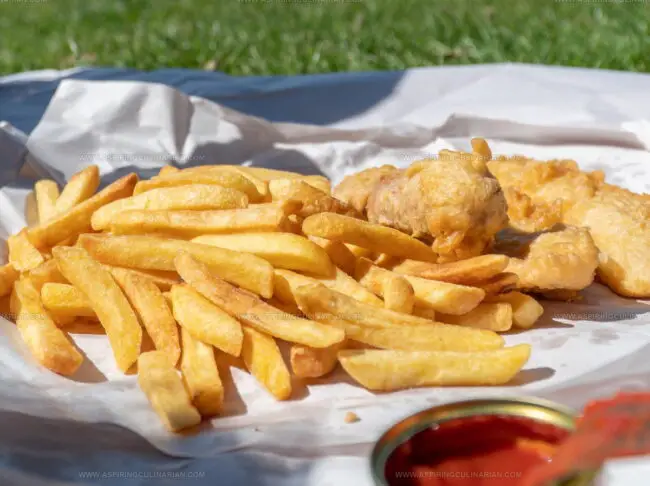

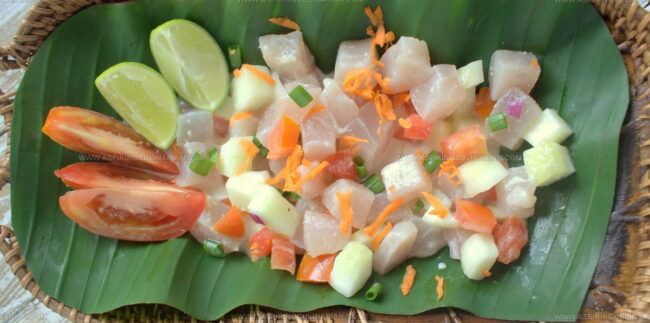
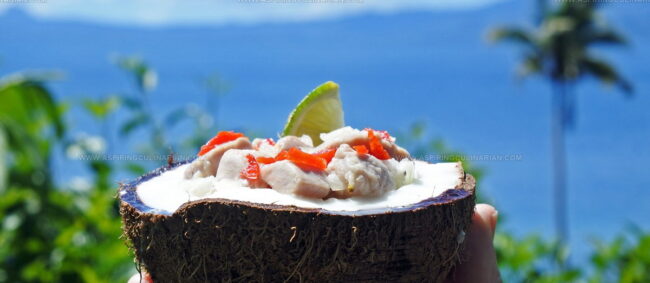
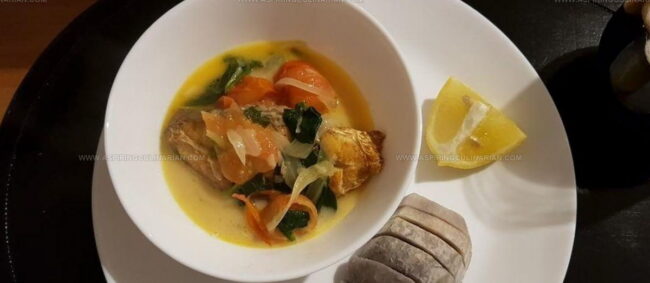
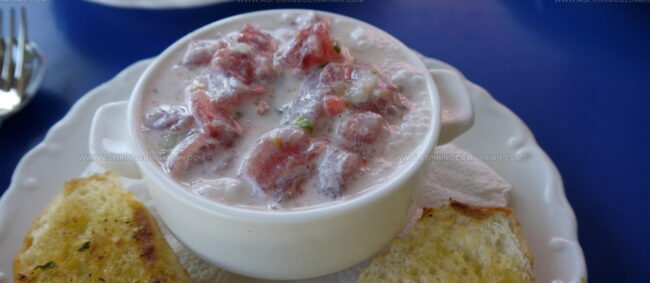
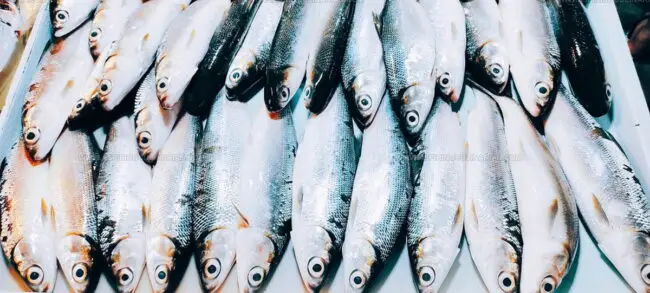
Lena Martinez
Contributing Writer & Culinary Educator
Expertise
Southwestern and Latin American cuisines, Vegetarian and plant-based recipe development, Culinary education and community outreach
Education
Santa Fe Community College, Santa Fe, NM
Certificate in Culinary Arts
Emphasized Southwestern cuisine and sustainable cooking practices
Lena grew up surrounded by the colors, spices, and traditions of the Southwest – flavors that sparked her love for bold, honest cooking. After earning her Culinary Arts certificate at Santa Fe Community College, she made it her mission to teach home cooks how to create flavorful, plant-powered meals without the fuss.
Her recipes are packed with vibrant ingredients, simple steps, and the kind of heart that turns a regular meal into something you’ll want to share. Outside the kitchen, Lena spends her time wandering farmers’ markets, trading family recipes, and helping young chefs find their voice through food.